Table of Contents
Background:
Recently I saw this post where a member of the Equilibrium Tuning team was promoting the Blaze ATOM intake to a consumer who already owns a Racingline intake:

The reference to multiple people with Racingline intakes that had swapped to the Blaze ATOM intake prompted me to search for another comparison of the Racingline and ATOM V2 intakes, (besides the tests I have done, and the information provided by Brett Harrison – discussed in the Blaze Intake Real World Data Check post.)
Searching turned up this person who had a Racingline R600 intake and switched over to the Blaze intake around the time the intake popularity was taking off.

While I could not find a statement from the owner that they decided to go with the ATOM V2, a post made by Matt Ferreira of Equilibrium Tuning indicated that was the product selection Tyree made.
Matt’s post contains an additional set of logs that are useful for comparing the before and after performance differences.
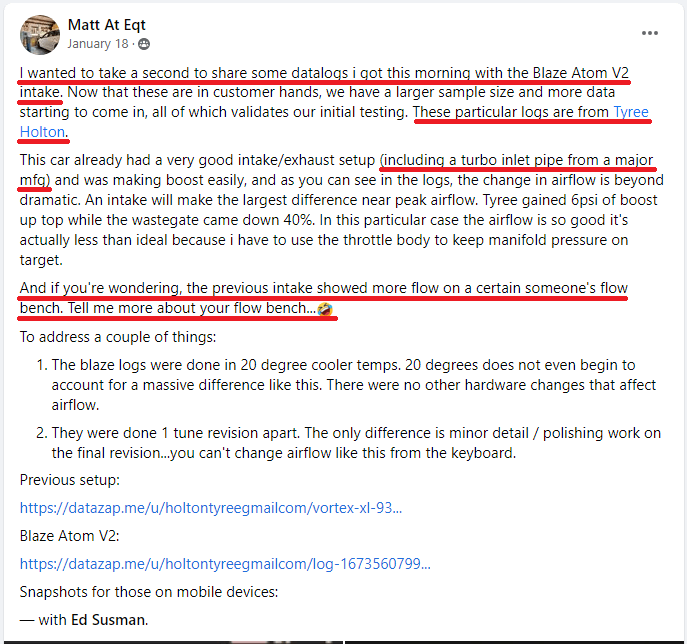
Importantly, all Matt says about the “before” intake setup is that it is a “very good intake/exhaust setup (including turbo inlet pipe from a major mfg)“.
I’ll illustrate shortly why it’s important to be specific about the products under test instead of generalizing an opinion about the intake and inlet pipe that are being compared.
As stated in Matt’s post, there is a significant difference between the data logs for the two setups, with the Blaze intake log showing an increase in boost pressure.
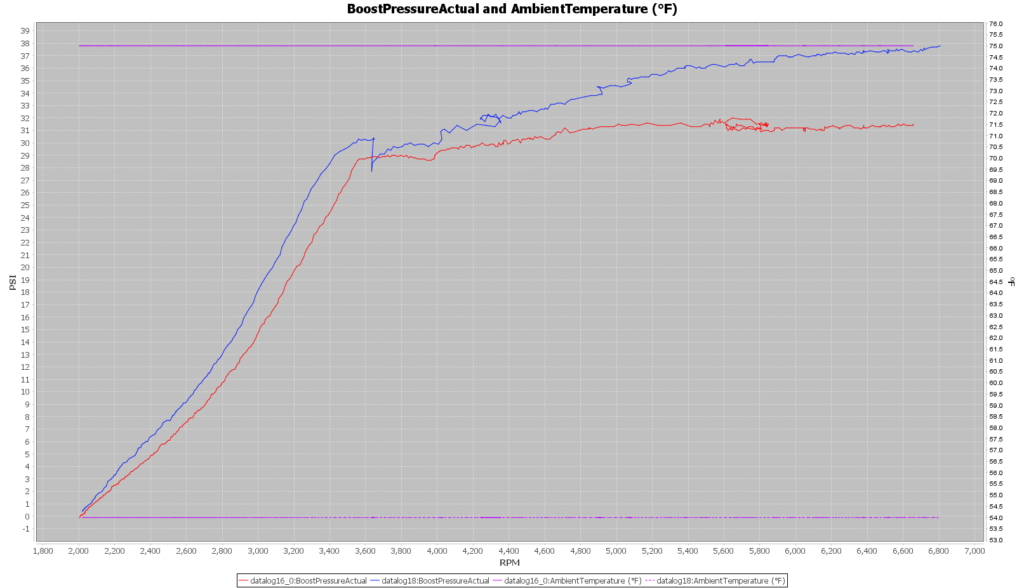
The 21-degree difference in ambient air temperature confounds the comparison of the hardware since cooler air doesn’t require as much work to compress to an equivalent pressure.
For this comparison, there is a larger problem, but at the time of this post, it was not addressed.
Matt’s post was followed shortly thereafter by other members of EQT contributing:

Along with them mentioning that EQT had more Blaze intake products ready to sell:
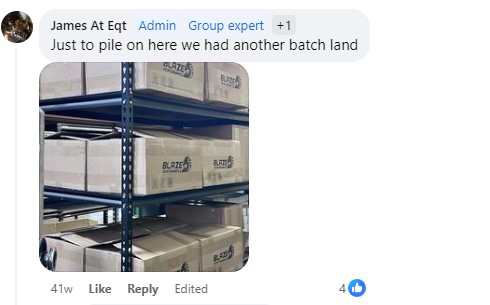
Details:
Buried in the series of comments from consumers is an important question – what size turbo inlet elbow/pipe (TIP) was paired with the “R600” setup?
Matt said it was a “very good intake” from a “major mfg“, but importantly failed to identify the specific part that Tyree was using at the critical location of the turbocharger inlet.
Fortunately, Theodore thought to ask this question:

APR was what I was running.
Tyree Holton
Analysis:
What about that APR turbo inlet elbow being used with a Racingline R600 intake in this comparison? Are they a good combination to use on a Vortex XL hybrid turbocharger?
The APR turbo inlet elbow is designed for use with a stock IHI IS20 / IS38 turbocharger.
This upgrade is recommended at all stages utilizing an IHI IS12, IS20 or IS38 turbocharger!
APR
With an outlet measuring 48.7 mm in diameter the APR elbow is appropriately sized to work with the 49 mm diameter IHI turbo compressor inlet. It does not take advantage of all the area of the 56 mm Vortex turbo inlet, such as a DBV2 TIP (55.3 mm) or Blaze flange (55.7 mm), does.
Out of the box, the APR TIP is a poor choice for use with a Vortex (56 mm inlet) turbo and guarantees suboptimal performance in this application.
The APR inlet elbow was one of the first that I tested in 2018 when it showed minimal gains over the stock elbow and placed last of the aftermarket elbows I tested, a ranking it still holds today.
Shown below are the flow test results of several stock turbo-size elbows attached to a hybrid simulating adapter. (Skip to the bottom of the chart to find the APR results):
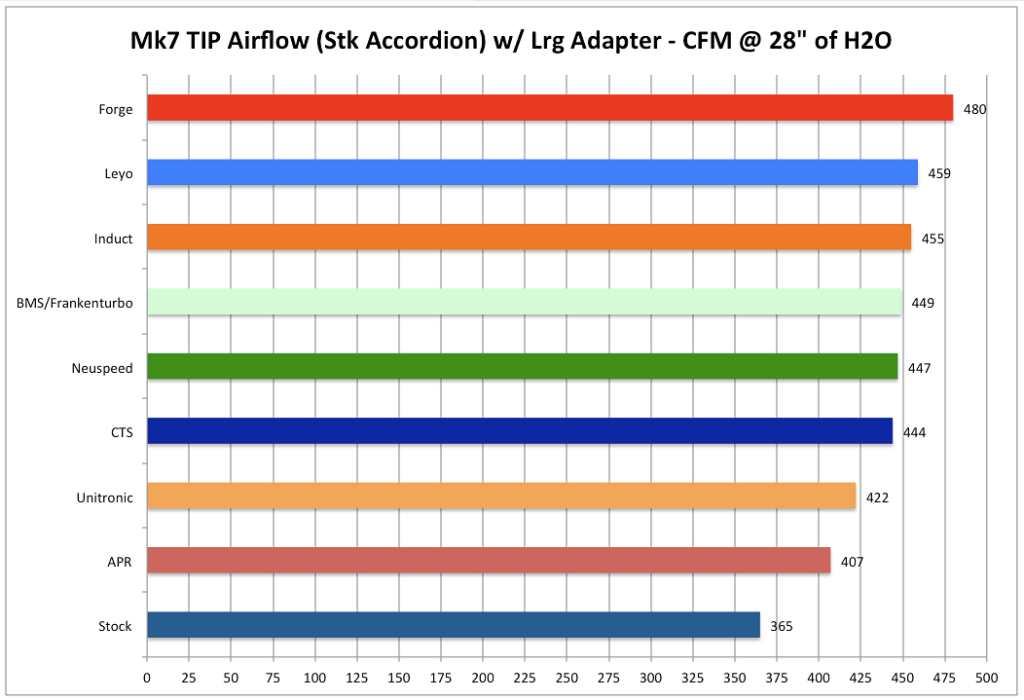
The top-flowing Forge inlet elbow isn’t hybrid optimized, like the DBV2 elbow, and still, it produces an 18% increase in airflow over the APR inlet elbow.
Blaze & R600 Comparison Results:
Matt Ferreira from Equilibrium Tuning states:
And if you’re wondering, the previous intake showed more airflow on a certain someone’s flow bench. Tell me more about your flow bench…
Matt Ferreira – Equilibrium Tuning Inc. employee
The significance of the contribution of the turbo inlet elbow to intake airflow has been well established. Inexplicably this employee from Equilibrium Tuning fails to consider the possibility of the APR turbocharger inlet elbow contributing to the outcome, instead erroneously concluding that the Racingline R600 intake has produced the difference.

Testing the R600 with a hybrid appropriate DBV2 TIP (55.3 mm outlet ID versus 48.7 mm of the APR TIP) showed the R600 flows slightly more than the Blaze ATOM V2 (55.7 mm outlet ID), although not by enough that would likely be detectable on the car.
Matt Ferreira’s failure to account for the inlet elbow being a contributing factor affecting induction system airflow leads him to mistakenly compare intake airflow rates that I have published.
If Matt had accounted for the turbo inlet elbow being a critical component then he might have looked at the TIP airflow rate summary instead and seen that the APR elbow, which Tyree’s car was originally equipped with, was a significant cause of airflow reduction for a hybrid size turbocharger, like the Vortex XL on Tyree’s car.
As it was, Matt’s error went unnoticed, and celebrating ensued over how well the Blaze ATOM V2 intake appeared to perform.
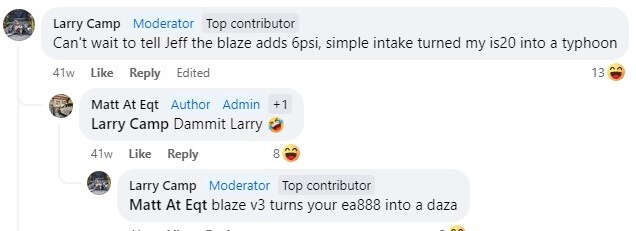

Conclusions:
Matt Ferreira from Equilibrium Tuning presented consumers with a pair of data logs from a car that changed between two different intake system hardware setups operating under meaningfully different ambient air conditions.
Matt Ferreira concluded that the Racingline R600 intake was a factor limiting the performance output of the vehicle when compared to the same car equipped with a Blaze ATOM V2 intake.
This conclusion overlooked the fact that the data recorded with the Racingline intake also included an APR turbocharger inlet elbow (TIP) that is designed for use with a stock IHI IS20 / IS38 turbocharger – when the subject vehicle was using a Vortex XL hybrid-turbocharger.
Amongst several aftermarket turbocharger inlet elbows, the APR product has been found to flow less than all of the other aftermarket products that have been tested.
This review is the fourth example of “real world” results for the Blaze intake being compared with another aftermarket intake system that was hamstrung by the use of a stock-size turbocharger inlet elbow.
It would seem that a fair “real-world” comparison of the Blaze ATOM V2 intake with another aftermarket intake is an elusive task. If somebody reading this post knows of a fair comparison, please post a link to it in the comments.
Implications:
The significance of Matt Ferreira’s failure in critical thinking is consequential.
Not only does Matt make a gross error overlooking a significant contributing factor when making his conclusion, but he also gloats over his conclusion, leading some consumers to mistakenly believe airflow measurements made with a purpose-built device are unreliable.
The fact that Matt Ferreira’s comparison post was made nearly one year ago, and a year later Aaron Zambrano of EQT is referencing its erroneous conclusion as a reason to purchase the Blaze ATOM intake over the Racingline intake suggests that even after a year the personnel at Equilibrium Tuning are still unaware of the significance that the turbocharger inlet elbow has on the pre-turbocharger pressure losses.
This failure to recognize the importance of the turbo inlet elbow means that the consumers who are making purchases of intakes based on EQT’s advice are doing so based on bad information.

The Flow Bench doesn’t lie.
It does the one thing it is built for pretty well.
Unbelievable how EQT continues to falsely present information to sell these things to the hungry fanboy mouths. It’s unethical.
I agree. It not only hurts consumers, but it also hurts honest companies.
Hey I just saw a screenshot of my comment on Facebook(Steven Lovejoy). I just purchased the r600 upgrade. I’ll try and provide you with proper data logs to see if it’s worth it. I’m curious to see if there’s a change in WGDC.
Thanks! I look forward to seeing what results you get.